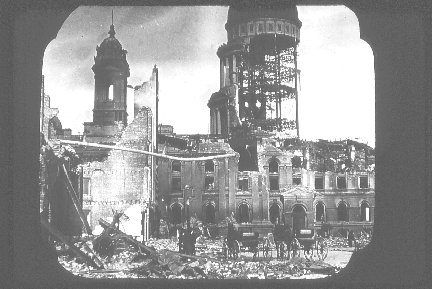
How to Survive a Great Earthquake
by Beulah
Mullen Karney
Text and Photographs © 2005 by Ann K Elliott
A Note About This Story: In 1981, with the approach of the 75th anniversary of the Great Earthquake of 06, the author of this story began reminiscing about the event which she, as a child going on seven years of age, had witnessed, and which memorable event had been deeply impressed onto her mind and psyche. In honor of the approaching anniversary she wrote the following story and organized the photographic gallery at the end of the story. It seems only appropriate that now, as the 100th anniversary approaches, the story and images be shared. Because the story was written 25 years ago some editorial comments are in brackets.
About the Photographs: In gratitude for the role William Mullen played in the aftermath of the earthquake, a photographer of the quake presented him with a set of photographic slides which for a number of years William used in giving lectures on the earthquake. The slides were later transferred to transparencies and from which the twenty photographs at the end of this story were taken.
THE STORY OF THE THIRD NIGHT
When catastrophe strikes, it usually happens that a few persons will come forward to do what needs be done. That is exactly what happened in the early morning hours that followed San Francisco’s double disaster: the earthquake and fire of 1906.
What took place then, and more importantly why it took place, will explain to us what plans we should be making today in event of, let’s say – an earthquake. In that city of nearly a half-million person, 300,000 found themselves actually imprisoned by a landslide that blocked the southern passage, a wall of fire behind them and the impenetrable sea on their north.
With the National Security Council in Washington warning us [1981] we are ill-prepared today to meet such an emergency, we should no longer put off making thorough plans for volunteer rescue work. The NSC points out, too, it will take at least six to eight hours in such a major earthquake before government personnel and equipment can be mobilized and deployed to the area affected.
I recall when the calamitous earthquake of that April 18th dawn struck, it was the quick response of volunteers that kept the death toll down to a total of less than a thousand persons. [a figure now questioned as far too low]
“During the period before the arrival of significant outside resources critical to the saving of lives of those trapped in collapsed buildings” says the White House Council “the public will be forced to rely largely on its own for search and rescue, first-aid and general life-saving action.”
Many people, I recall, expected an earthquake was imminent then. I was six-years-old, certainly old enough to remember my parents discussing the matter with us children. There was nothing to fear, they assured us, as long as we kept in mind what to do and remain calm.
I was aware also my father had met several times with a small group in our community to discuss what was to be done if such a catastrophe happened. Neighborhood schools and churches were the centers of social activity and know how to gather the community quickly whenever there was need. Most welfare crises were handled this way.
I have no memory of our family or our neighborhood playmates showing fear or hysteria. What I do recollect is how we made a game of sitting on the seemingly safe ground and putting our fore-fingers in the newly-formed cracks to feel the earth move. That was excitement!
However, my finest and most deeply felt emotion was of our family, all five of us, standing together on the street curb taking note of how the red flames leaped in the sky. My father’s face was grave. He did not speak for a long moment before announcing:
“I should go hitch up the team.”
He went to the barn immediately. His chores done, he entered the house by the back door. When he rejoined us, great smoke-clouds had already shut out the sky. So serious he was, we know there was little time to lose.
“God calls.” His voice was steady; his eyes were still fixed toward the bay. He knew the significance of a blazing waterfront: he ferried to his work in San Francisco almost daily.
Then, he kissed us, each one, and advised: “Do not worry, but pray. When my work is done, I shall return.
Soon, his high-wheeled cart, drawn by a pair of chestnut standard-breeds could be seen swerving around the curve—driven by this power of a man who, by the erectness of his back, revealed how anxious he was to accept whatever task he was called to do.
An Oakland newspaper reported that he and a small group of church workers called on Mayor Eugene Schmitz and Governor George Pardee early that morning to learn what help Oakland might give. He knew them both well. My mother cut out such clippings and kept them in a scrap-book, so what we could not comprehend then, we were later able to understand.
Also, to supplement my little-girl memory, I have additional reference material in a collection of photographs a newspaper reporter gave us, [included at end of story.] Papa had them made into stereopticon slides to illustrate the lectures he sometimes gave before civic clubs or school groups. He never lost an opportunity to explain the value of being ready. I heard his account of the earthquake enough time to remember most details.
One thing he mentioned about that terrible first day was that, when he was assembling the rescue squad, he found “it saved time to seek out the humble, God-consecrated workers.” Somehow, they had the courage to enter burning buildings and carry out the wounded or dying.
Some thirty-five years later, when I was doing research in the Newberry Library in Chicago, I was to learn why he chose to talk about the more heartening experiences that happened later in the week.
Quite by chance, I picked up a book which was a compilation by the survivors and rescuers of the “San Francisco Horror.” There I read how the only hospital that survived the first hours was the General Hospital, so other emergency facilities had to be improvised. And, in that Chicago library, my eyes fell upon a full-page photograph of one of these open--air morgues in Jefferson Square, where the soldiers, aided by volunteers, had removed the stricken out of the fire area. Covered caskets were placed in rows on the grass, including some infant-size ones.
There, leaning against a stone table, stood my father—alone among the dead. Gone was the earlier erectness. Heart-burdened, now, he stooped as he wrote in an open register, the names of the dead, or their descriptions so that, later, those who came searching for loved ones might identify them. It had become his task to reunite families and, later, to find a safe haven for them. There was no mistaking him in his oxford-grey suit, the stiff cuffs of the bosomed shirt fringing the coat sleeves, black bow-tie, and the brimmed Stetson he always wore.
At 2:25 that first afternoon, another strong earthquake struck, causing crazed crowds to hurdle rubble-filled streets to reach the ferry landings. Oakland was recognized by all as the Haven of Hope. When a ferry pulled into the slip, some even tried to climb over the iron gates, and had to be protected by the militia. By ten o’clock, the fire was unabated.
My father reached the east shore in time to help organize the Oakland Relief Committee of One Hundred. Chosen a member of the executive board, he was assigned to head the transportation committee.
These civic leaders were just as earnest to save The City across the Bay as if it had been their own. Each one must have left a graphic, personal story to pass on to his children, but I can only relate what I learned about those hardy invulnerables first hand. One person’s work was no more necessary than the others’. Each one, in his own way, had a talent to offer, and when combined with the talents of all the others’, it contributed mightily to the survival of The City.
As it so happened, Father’s early life had conditioned him for his particular role. At the age of eleven, he put to sea, a lone Irish emigrant, working his way as a galley boy on a ship bound for San Francisco with ports of call Baltimore, Rio de Janeiro, Calloa, Honolulu and San Francisco. He took a six year stop-over in Hawaii where he learned his trade of horse training.
His talent with horses earned him a job with Speckles, the Sugar King, at his Maui plantation.
In 1883, he was assigned to escort a valuable cargo of blooded horses from Sprecklesville to the San Francisco stables. He remained to become The City’s expert horseman and trainer whose services soon became in wide demand. It was the era when the well-trained horse carried social prestige. My father schooled many in the late 80’s and 90’s to fourteen gaits. He was also the trainer of the swift, race horses for the California Blood Horse Association. This put him in constant association with the rich and powerful, to function with dispatch in such an emergency.
Thus it was natural that Professor William Mullen, or just “The Professor” as he was usually called, became the director of transportation, in charge of disbursing the thousands of refugees, out of The City in time.
On the morning of the second day, The Professor returned to San Francisco, after working the night through.
There were now five times the number of homeless in the almost-demolished city—fifty thousand alone in Golden Gate Park. Relief Centers were being established in Oakland, as well, but it was difficult to get the hordes across. Later that morning, plans to move out all the now-destitute got underway when the Santa Fe and Southern Pacific Railroads agreed to transport, free of charge, all who wished to leave, although it was not to be announced until a workable plan could be carried out.
By four o’clock, a semblance of the water service was patched up, and elsewhere, the fire squad was pumping water from the bay. But drinking water was scarce; the rolling water wagon was guarded by soldiers and rationed by the cupful.
Governor Pardee that night sent out the first wire message for food. Women in Oakland including my mother and other neighbors, made bread, and two bakeries that could operate, baked the loaves. There was hardly a chimney standing in our city. From as far away as Los Angeles, the supply trains pulled into the Oakland shed which became piled high with the home-made loaves.
But when the trains moved southward, only a scattering-few had been able to get through the wall of flames that imprisoned them in the relief camps of The City’s outskirts.
Dawn saw every able-bodied man still on the fire line. Since no one had time to bury the dead, the condition of the bodies became dangerous and the old and the weak were chosen to dig the graves.
Tug-boats transported tons of supplies from Oakland, while carts and drays relayed them to the fifty-two substations and warehouses throughout the various sections of the area. But because all available help was needed to fight the fires, no one was free to distribute the supplies to the people. The City now faced starvation.
That night—the third night—San Francisco was a twenty-square-mile area of blackened desolation. Its wealthiest area was in ashes; sixty thousand buildings had become a thirty-foot rubble heap.
Suddenly a gale swept from the west, fanning the embers into fierce flames. The fire, which had been thought to have practically burned itself out, revived by the wind, moved eastward and threatened to destroy the entire waterfront, including the Ferry Depot. Such a disaster would destroy the only means to transport the homeless out of The City. The only way to get into or out of the peninsula was by row boats, or floats, or by foot over the blocked, overland, south passage.
Men, in tug-boats, were ably holding their own fighting the fire. Then suddenly it became obvious that more help was needed. Two vessels were ordered to the spot. When these arrived, they needed more volunteers to help the sailors aboard hold the hose lines. Few refused. Yet pale, hungry men, many of whom had not slept, and some who had not eaten for forty-eight hours, rallied around the crew and held on to the hoses while sailors aimed the streams of water pumped from the bay upon the persistent flames. It worked! At three-thirty, the fire was conquered. This time it held.
Soon at daylight, the fire was under complete control. minutes later, couriers on sure-footed horses carried the news to the relief camps that the Southern Pacific Railroad had offered free transportation to all who wanted to leave The City for any destination on its line in California. The Professor, able horseman that he was, knew what he was called upon to do.
Everyone worked in single-minded zeal to begin to move out the refugees as swiftly as possible. The best-trained horses were selected, and the most talented horsemen-couriers were put upon their backs to synchronize the train movement information given by the railroad agents to the volunteer relief committee aides. The news was forwarded, in all haste, to the people in the relief camps who had to be readied to depart.
Three-fourths of the city’s population were huddled together in these relief camps, but at dawn, led by the soldiers, they began moving out. They were headed in the direction of the Ferry Depot.
Once on the shore of the East Bay, some decided to remain, yet a little while longer, in hope of finding lost, loved ones. Those who had arranged to accept the free transportation went to the huge, brown shed, the Oakland Mole. Haggard and begrimed, they milled about the station, the tragedy and hazards of the past three days and nights apparent on their always-searching faces.
The Professor was there to make certain the committee’s plans were carried out. A big man, he towered over most others. Numerous aides worked beside him. Everything was orderly until the first, free train pulled into the Mole.
As though directed by one mind, those who had been hoping against hope they would escape, faced with the reality they could leave, rushed madly towards the incoming train. This time it was not from the fear of falling buildings, or the uncontrolled fire. It was from fear they might be left behind! Like rampaging cattle, they pushed and shoved and knocked down one another, intent on being the first to board the train—without even waiting for it to come to a complete stop.
Having lived a life crowded with catastrophe, the Professor acted intuitively, swiftly, and from his long experience with wild animals. He knew that human beings, more sensitive than either cattle or wild horses, were hardest of all to control in a terror panic—a stampede. So jumping on a pile of freight containers, he boomed out in his commanding voice:
“God is not dead!”
That was all he said. One short sentence; yet it was enough to bring them to their senses. The fearful became silent. Still standing on his box platform, he gave them necessary information: how the trains would be coming in all day; that there would be a seat for every man, woman, and child. He made it a point to tell them that those who could not leave today would have the opportunity to leave tomorrow, or, on the next day, or still, again on yet another day, until everyone was taken care of.
As they listened, in quiet confidence he assured them relief aides would board the trains to help them in any way. Then he directed them, each one, to form a single line, and start to board the cars in turn.
Twenty-five thousand departed that Saturday in trains that came in quick succession. Twenty-five thousand marveled at the miracle that they were still alive.
On Monday, a forth stiff earthquake was again felt. The next day, the Oakland Mole was filled with an increasing number of anxious travelers. Only 175,000 inhabitants remained to rebuild a new city. But they were enough.
It was, however, not until 1931 before my father told me the full story of how almost an entire city’s population had been moved out within those morning hours of the forth day. And so I tell it for a first time.
Looking back on sixty-five years crowded with crises, he had an easy explanation how so massive a movement had been so quickly accomplished: He repeated one of his favorite quotations:
“For God hath not given us a spirit of fear; but of power, and of love, and of a sound mind.”
PHOTOGRAPHS OF THE
SAN FRANCISCO 1906 EARTHQUAKE

I.
City Hall: It Took Seven Years to Build
(and
Seven Seconds to Destroy)

II.
Volunteers Helped Clear Streets

III.
Walking was Difficult, But the Only Way
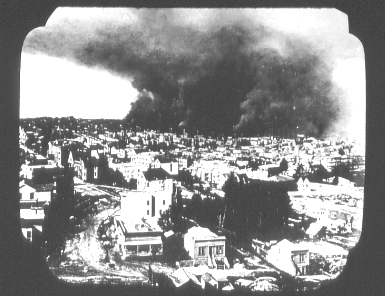
IV.
Smoke Billows Were Five Miles High
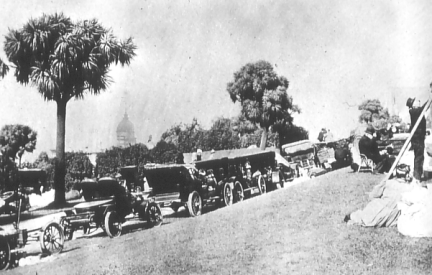
V.
Vehicles Could be Commandeered for Service
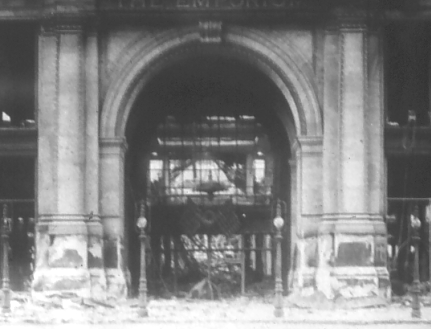
VI.
The Emporium was Total Destruction Inside
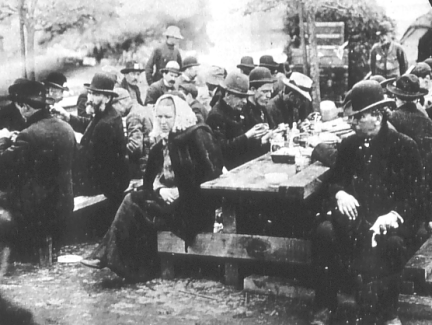
VII.
Three-fourths of the Population Were Fed
in
Open-air Relief Kitchens
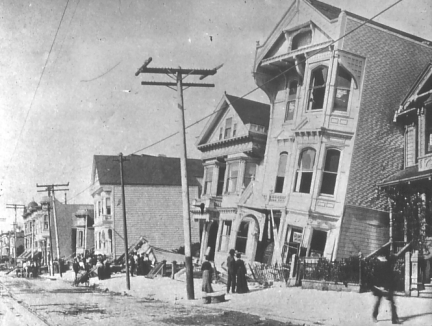
VIII.
Buildings Tilted Sideways and Sunk Backwards
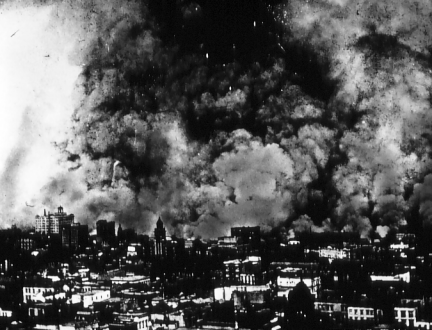
IX.
Flames Burst Out in Fifty Different
Directions
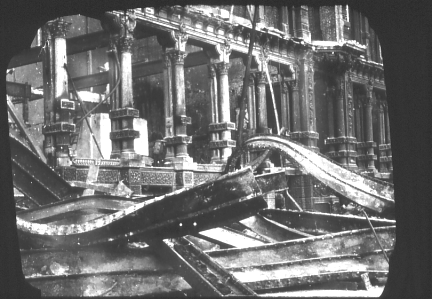
X.
Twisted Girders and Broken Beams at Taylor
and Geary
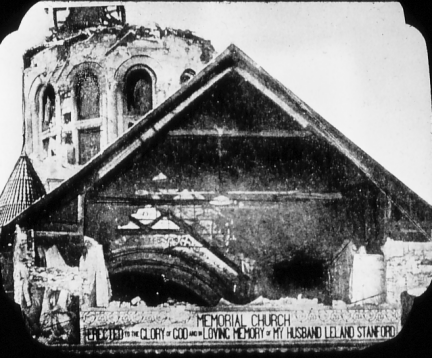
XI.
Outlying Towns Suffered. Leland Stanford
Chapel

XII.
Mayor Eugene Schmitz—a Man of Action
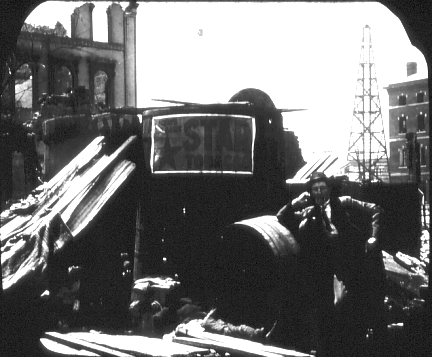
XIII.
Home Could have Been a Barrel and a Blanket
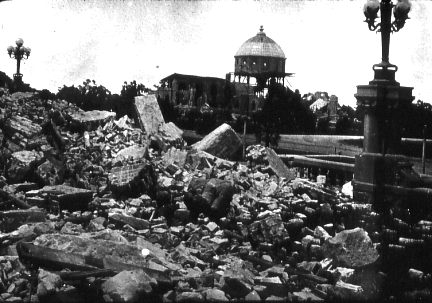
XIV.
Rubble Piles Were Thirty-feet High
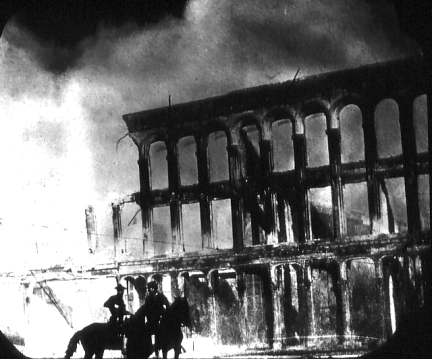
XV.
Cavalry Kept People Away From Danger

XVI.
Refugees Stood in Line for Free Supplies
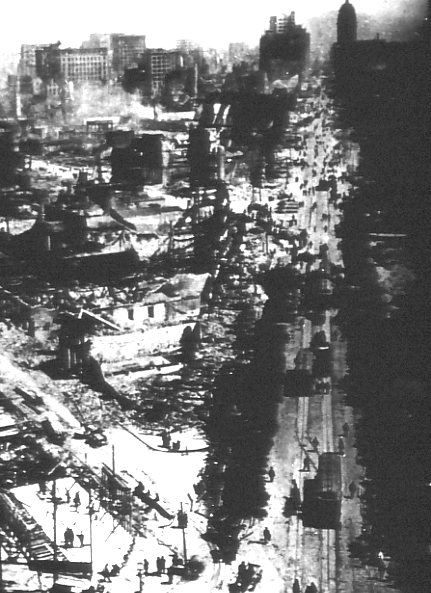
XVII.
All That was Left of the Thoroughfare
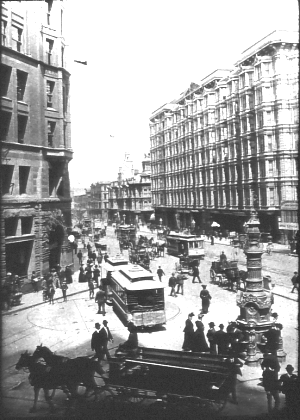
XVIII.
Market Street the Week Before
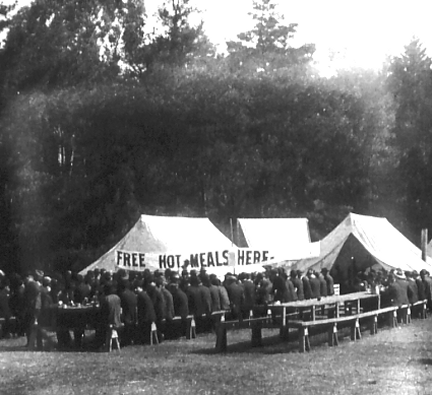
XIX.
Oakland Was the Haven With its Relief Camps
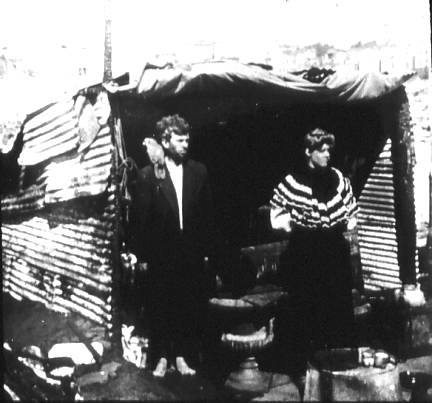
XX.
Home Was How One Made It